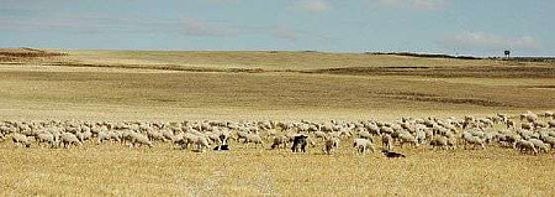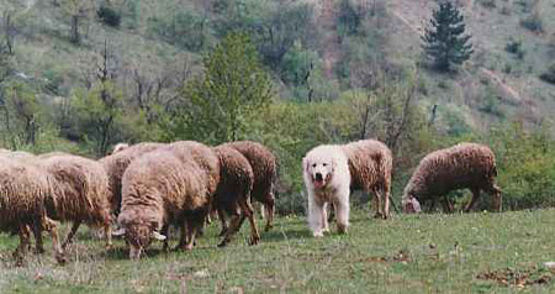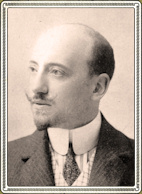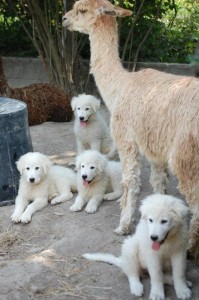
Emblematica immagine di transumanza sul tavoliere di puglia
The outliving of livestock guarding and protecting functions in Maremmas is strongly bounded not only to the presence of predators, but rather to the typical demands of the traditional pastoralism and hence the transhumance, meaning the regular migration of livestock from the spring-summer mountain pastures to those in the valleys in autumn and winter. Hence, transhumance is the recurring livestock transfer (mainly sheep, but only) between two or sometimes more complementary pastures, moving between valleys and mountains on a seasonal basis.

Pastore abruzzese in primo piano durante un momento di transumanza orizzontale
Environment and climate are the two prerequisites of the transhumance and influence it continuously in time and space; areas under particular political and economic influence may cause significant changes. Transhumance can be horizontal, also called Mediterranean, or vertical, called alpine; these two kinds are connected to environmental and economic situations in a different way. The adjectives “vertical” or “horizontal” refer to either a change of altitude between mountain tp and valley, or a significant movement between two geographic areas.
The horizontal transhumance is typical of those areas that are distinguished on the one hand by mountains that are covered in snow in winter, and can hence conserve a great quantity of humidity to offer florid pastures in spring and summer, and on the other hand by valleys arid in summer but great for pasturing in the colder seasons. The vertical transhumance is typical along all of the Alpine Arch. There, the livestock is kept mainly on hay in the stables during the colder seasons, and is led out to the pastures around June where it remains up until late September.
Numerous of Mediterranean European countries were involved in the transhumant pastoralism: Spain, France, Switzerland, Germany, Carpathians, the Balkan Countries and Italy, where the transhumance had been affecting areas of Central and Southern Apennines and the valleys of Apulia, Campania and Maremma for centuries.
Numerous of Mediterranean European countries were involved in the transhumant pastoralism: Spain, France, Switzerland, Germany, Carpathians, the Balkan Countries and Italy, where the transhumance had been affecting areas of Central and Southern Apennines and the valleys of Apulia, Campania and Maremma for centuries.

Gabriele D'Annunzio
As for the horizontal transhumance, which means the moving from one pasture to another, generally done by foot along centuries-old itineraries, passing through areas engaged in different commercial and agricultural activities.
The transhumance was conducted along public roads, so that the sheep could pasture along the brims as they went on, but especially along the droveways, huge grassy roads that could be followed by herds, shepherds and their dogs for hundreds of kilometers. In their widest points, the droveways, “tratturi” as they are called in Italian, could reach as much as 111 meters: from these main “arteries” departed smaller “tratturelli”, around 37 meters wide, that were connected between them by branches of about 18-19 meters wide.

Cuccioli di pastore maremmano abruzzese con un’alpaca di razza Suri, l’alpaca più’ raro al mondo.
Service areas, plains rich in grass and water, could be found along the droveways, where the flock could rest for up to three days. The decline of the transhumance, a tradition known as long past as III century AC, led to a breakdown of the once florid craftsmanship connected to it, as well as of the commerce that allowed to integrate the necessities and resources of the mountains with those of the valleys. Usually shepherds or their auxiliaries escorted the livestock. The dogs merged among the sheep or went ahead, waiting for the flock to arrive in the shadow of a tree.
Nowadays, the sheep travel on board of trucks or trailers suitable for livestock transport. In this way, the travel time is reduced to 24 hours, helping saving time and energy. The animals surely benefit from this way of transportation, as the long and arduous journey of the transhumance that lasted for days would in the long run have adverse effects on the wellbeing of pregnant or lactating females as well as of youngsters.
Segui l’approfondimento sul cane della transumanza. Iscriviti alla Maremmano Abruzzese TV
Video di approfondimento sul cane della transumanza
Glossary / Definitions
Transhumance
“Vertical” when from the topographic point of view the vertical transfer is particularly significant when compared to the horizontal distance (from the valleys to the pastures on top of the mountain). On the other hand “Horizontal Transhumance” refers to movements that cover ample distances with rather insignificant altitude differences.
Droveway (Tratturo)
A broad trail shaped and molded by the recurring flock transfer. The tratturo represents the habitual itinerary for livestock moving from summer to winter pastures. It derives from the latin word tractorium. As Alfonso I of Aragona established the sheep customs, the network of the droveways was drafted that is still valid today.
Monticazione
Operation of transferring the livestock from the valley (or stable) to the summer pasture in the mountains.
